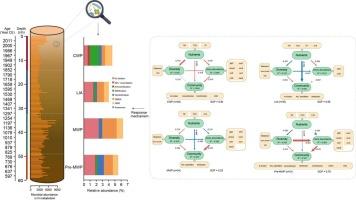沉积记录的氮转化微生物反映了青藏高原冰湖千年时间尺度上的气候波动
IF 2.5
3区 环境科学与生态学
Q3 ENVIRONMENTAL SCIENCES
引用次数: 0
摘要
利用沉积古DNA (sedaDNA)揭示了青藏高原嘉陵湖1400年来负责氮转化的微生物群落的时间动态。我们的研究结果表明,与n转化反应相关的微生物组成的变化点发生在~ 769 CE、~ 1286 CE和~ 1850 CE,比相应的记录气候阶段——中世纪温暖期开始、中世纪温暖期和小冰期之间的过渡以及小冰期和当前温暖期之间的过渡——分别早了大约0-30年。参与N2固定和异化硝态氮还原(DNRA)的优势菌属螺旋体(Spirochaeta)和厌氧杆菌(Anaeromyxobacter)急剧减少,而参与NH4+同化、氨化和硝化作用的主要菌属Iamia、Chitinophaga、Nitrospira和Nitrosospira在~ 1300 CE时发生了增加的变化。这些变化与总氮(TN)含量、总有机碳(TOC)含量和有机碳氮(C:N)比的明显下降以及TP含量在~ 1300 CE时的显著增加密切相关。偏最小二乘路径模型表明,气候波动引起的养分变化是微生物群落演替中氮转化的主要驱动力。不同气候时期的群落结构主要是由微生物类群对养分负荷的偏好引起的。本文章由计算机程序翻译,如有差异,请以英文原文为准。

Sedimentary recorded nitrogen-transforming microbes reflect climate fluctuations in a glacial lake on the Qinghai-Tibetan Plateau over a millennium timescale
We used sedimentary ancient DNA (sedaDNA) to reveal the temporal dynamics of the microbial community responsible for nitrogen (N) transformation within Lake Gyaring located on Qinghai-Tibetan Plateau over the past 1400 years. Our results revealed that the change points of microbial composition linked to N-transforming reactions occurred at ∼769 CE, ∼1286 CE, and ∼1850 CE, preceding the corresponding recorded climatic stages—the beginning of the Medieval Warm Period, the transition between the Medieval Warm Period and Little Ice Age, and the transition between the Little Ice Age and the Current Warm Period, respectively—by approximately 0–30 years. The dominant genus Spirochaeta and Anaeromyxobacter participating in N2 fixation and dissimilatory nitrate reduction to ammonium (DNRA) underwent a sharp decrease, while the prevalent components Iamia, Chitinophaga, Nitrospira, and Nitrosospira involved in NH4+ assimilation, ammonification, and nitrification exerted an increase shift at ∼1300 CE. These variations closely matched evident decreases in total nitrogen (TN) content, total organic carbon (TOC) content, and the organic carbon to nitrogen (C:N) ratio, as well as a noticeable increase in TP content at ∼1300 CE. Partial least square path modeling revealed that those nutrient variations induced by climate fluctuations were the predominant driver for the microbial community succession with respect to N transformation. The prevailing community structure across distinct climate periods mainly arose from preferences of the microbial taxa for nutrient loading.
求助全文
通过发布文献求助,成功后即可免费获取论文全文。
去求助
来源期刊

Journal of Great Lakes Research
生物-海洋与淡水生物学
CiteScore
5.10
自引率
13.60%
发文量
178
审稿时长
6 months
期刊介绍:
Published six times per year, the Journal of Great Lakes Research is multidisciplinary in its coverage, publishing manuscripts on a wide range of theoretical and applied topics in the natural science fields of biology, chemistry, physics, geology, as well as social sciences of the large lakes of the world and their watersheds. Large lakes generally are considered as those lakes which have a mean surface area of >500 km2 (see Herdendorf, C.E. 1982. Large lakes of the world. J. Great Lakes Res. 8:379-412, for examples), although smaller lakes may be considered, especially if they are very deep. We also welcome contributions on saline lakes and research on estuarine waters where the results have application to large lakes.
 求助内容:
求助内容: 应助结果提醒方式:
应助结果提醒方式:


